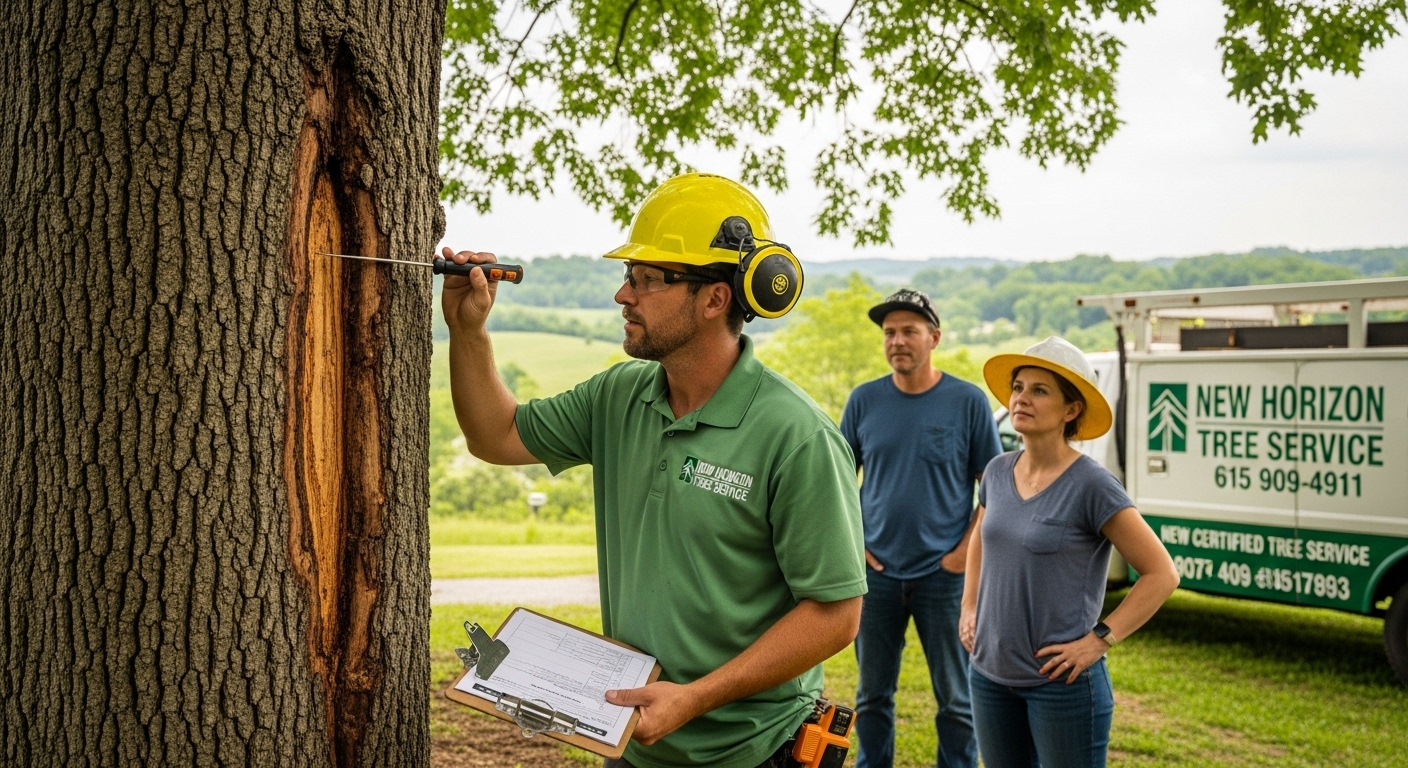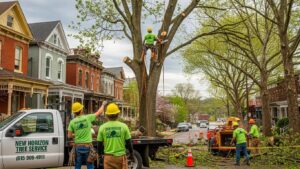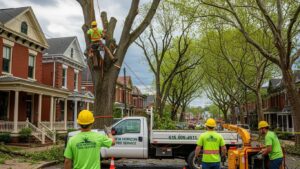Removing a tree from your Nashville property is never an easy decision. Whether you’re near Percy Warner Park in Belle Meade or maintaining a historic property in Germantown, understanding when tree removal becomes necessary protects both your home and your investment.
This comprehensive guide helps Nashville homeowners recognize the critical signs that indicate a tree must come down—and when professional intervention can save a valuable specimen.
Recognizing Immediate Safety Hazards
Structural Compromise Signs
Trees showing structural failure require immediate attention from a professional tree service in Nashville. Look for these critical warning signs:
Trunk damage indicators:
- Significant cracks extending through the main stem
- Visible cavities exposing more than 30% of the trunk’s circumference
- Splits that penetrate deep into the wood
- Hollow or punky wood when probed
In neighborhoods like Green Hills and Forest Hills, mature oaks and maples commonly develop these issues as they age beyond 80-100 years. These structural defects don’t heal—they worsen over time.
Leaning tree assessment:
A leaning tree presents serious risk when:
- The lean exceeds 15 degrees from vertical
- Soil heaving appears at the base
- The lean developed suddenly (versus gradual growth lean)
- Cracks appear on the tension side of the lean
Properties near Radnor Lake often experience sudden leaning due to the area’s clay-heavy soil that shifts during wet winters and dry summers.
Disease and Decline Indicators
Progressive Health Deterioration
Dying trees show declining health over multiple growing seasons. Recognizing these patterns early allows time for treatment—or planned removal before emergency situations develop.
Premature leaf drop or reduced leaf size
When trees in 12 South or Hillsboro Village consistently lose leaves in August rather than October, or produce leaves 50% smaller than normal, systemic problems exist. This indicates:
- Vascular disease blocking water transport
- Root disease limiting nutrient uptake
- Advanced pest infestation
- Irreversible decline
Extensive dead branches throughout canopy
Dead wood exceeding 25% of the crown indicates the tree cannot sustain its current structure. This condition:
- Creates falling branch hazards
- Invites secondary pest infestation
- Signals advanced internal decay
- Rarely reverses without major intervention
This pattern often affects ash trees throughout Nashville due to emerald ash borer infestation—now present throughout Davidson County.
Bark abnormalities
Peeling bark, vertical cracks, or missing patches reveal vascular system failure:
- Sunken or discolored bark areas (cankers)
- Oozing or bleeding from bark
- Large sections of loose bark
- Bark sloughing in sheets
Drought stress accelerates these symptoms in areas with poor soil drainage.
Insect Infestation
Severe pest problems compromise tree health beyond recovery. Key infestations in Nashville include:
Emerald Ash Borer (EAB)
This invasive pest has devastated ash populations throughout Davidson County. Once infestation reaches advanced stages, removal becomes necessary:
- D-shaped exit holes in bark
- Serpentine galleries under bark
- Crown dieback exceeding 30%
- Increased woodpecker activity
Other serious pests:
- Asian longhorned beetle (maples, willows)
- Southern pine beetle (pines)
- Ambrosia beetles (stressed hardwoods)
When infestation reaches advanced stages, removal prevents spread to neighboring properties and eliminates hazard trees.
Concerned about tree health? Our ISA Certified Arborists diagnose tree diseases and pest problems throughout Nashville. Early detection often saves trees
schedule a health assessment today.
Site-Specific Removal Considerations
Proximity to Structures
Trees planted too close to homes create inevitable problems. In Donelson and Hermitage, mature trees within 10-15 feet of foundations commonly cause:
- Foundation damage from root pressure and moisture changes
- Roof damage from overhanging branches during storms
- Gutter blockage requiring constant maintenance
- Moisture problems preventing foundation drying
Remove trees when roots consistently damage foundations, driveways, or underground utilities despite root pruning efforts. Properties near Percy Priest Lake often experience accelerated root growth due to water-seeking behavior in clay soils.
When removal makes more sense than repeated repairs:
- Root barriers have failed multiple times
- Damage repair costs exceed removal costs
- Tree species will continue aggressive root growth
- Structure integrity faces ongoing threat
Power Line Conflicts
Trees growing into power lines create safety hazards and service disruptions. While utility companies handle right-of-way trimming along major corridors through areas like Berry Hill and Oak Hill, property owners bear responsibility for trees threatening service lines to their homes.
Remove trees when:
- Main trunk grows directly under lines with less than 10 feet clearance
- Previous pruning attempts destroyed natural form
- Species will exceed safe clearance at maturity
- Repeated trimming creates hazardous branch structure
Driveway and Sidewalk Damage
Surface root systems that heave concrete create trip hazards and drainage problems. Throughout East Nashville’s urban forest, mature maples and sweetgums commonly lift sidewalks and driveways.
Consider removal when:
- Lifting exceeds 1.5 inches creating trip hazards
- Roots damage more than 30% of paved surfaces
- Repeated grinding hasn’t solved the problem
- Repair costs exceed removal and replacement costs
Often, stump grinding followed by replanting with an appropriately-sized species proves more economical than ongoing concrete repairs.
Wrong Tree, Wrong Place Scenarios
Inappropriate Species Selection
Some trees simply don’t belong in residential settings—and removal prevents inevitable problems.
Bradford pears
Popular in 1980s-1990s Nashville developments around Antioch and Madison, Bradford pears reach 25-30 years old and split apart during storms. Their weak branch unions make them unsuitable near homes. Removal before failure prevents:
- Property damage from splitting
- Vehicle damage in driveways
- Injury from falling branches
- Emergency removal costs (2-3x scheduled removal)
Fast-growing “trash trees”
Species like silver maples develop aggressive root systems and brittle wood unsuitable for areas near structures. In neighborhoods like Bellevue and West Meade, these trees routinely damage:
- Foundations and basement walls
- Septic systems and drain fields
- Driveways and sidewalks
- Underground utilities
Professional Assessment: When to Call an Expert
Schedule Professional Tree Assessment When:
Safety concerns exist:
- Multiple concerning symptoms developing simultaneously
- Uncertainty about tree stability after storms
- Trees leaning toward structures or high-traffic areas
- Visible decay or structural defects
Major projects planned:
- Construction or landscaping projects near trees
- Adding structures within root zones
- Grade changes affecting drainage
- Utility installation near mature trees
Real estate transactions:
- Buying property with large trees present
- Selling property with potential tree hazards
- Insurance requirements for hazard assessment
- Pre-listing inspection recommendations
What ISA Certified Arborists Evaluate
Professional assessment goes far beyond visual inspection. ISA Certified Arborists use specialized tools and techniques unavailable to homeowners:
- Resistograph testing measures internal trunk decay
- Sonic tomography maps decay patterns
- Root collar excavation reveals hidden decay
- Load testing assesses structural stability
- Laboratory analysis identifies disease pathogens
This comprehensive evaluation provides objective data for removal decisions—not guesswork.
Alternatives to Tree Removal
Before deciding on removal, consider whether intervention can save the tree.
Corrective Pruning
Trees with limited damage often respond to strategic pruning. Our branch and limb removal services can address:
- Dead or dangerous branches
- Storm damage cleanup
- Crown reduction for wind resistance
- Structure improvement pruning
This works well for basically healthy trees suffering isolated storm damage or minor disease issues. Crown reduction pruning particularly benefits properties in exposed locations along hillsides near Radnor Lake or ridge lines in Belle Meade.
Cabling and Bracing Systems
Trees with split or weak unions gain support from professional cabling systems:
- High-strength steel cables in upper canopy
- Threaded rod bracing through weak unions
- Dynamic or static systems based on needs
- Regular inspection and maintenance
Historic properties in Germantown and downtown Nashville frequently employ this technique for preserving mature specimens with sentimental or historic value.
Disease Treat111ment
Some conditions respond to treatment when caught early:
- Fungicide applications for leaf diseases
- Systemic treatments for vascular diseases
- Soil amendments for root diseases
- Integrated pest management for infestations
However, treatment only makes sense when the tree has reasonable recovery prospects. Advanced disease or decay typically can’t be reversed.
Timing Your Tree Removal
Optimal Removal Seasons
Dormant season (November-February) ⭐ Best overall timing
- Minimizes landscape disruption
- Easier access through dormant gardens
- Frozen ground supports equipment
- Often lower pricing due to reduced demand
- Better visibility of tree structure
Early spring (March-April)
- Pre-leaf-out removal prevents debris issues
- Allows immediate replanting
- Good timing before construction projects
- Weather generally cooperative
Avoid when possible:
- Peak growing season (reduces tree stress response)
- Severe weather periods
- Extremely wet conditions (soil damage)
- Holiday seasons (scheduling challenges)
Nashville-Davidson County Permit Requirements
Permits are required for tree removal in specific situations:
- Protected trees over 30 inches DBH (diameter at breast height)
- Trees in designated preservation zones
- Multiple tree removal exceeding cumulative diameter thresholds
- Trees in floodplain areas
- Historic overlay districts
Check permit requirements when:
- Removing trees over 24 inches diameter
- Located in historic neighborhoods
- Near streams or wetlands
- Removing multiple trees
Contact Metro Planning Department before removing large trees. New Horizon Tree Service assists with permit applications for qualifying projects.
Frequently Asked Questions
How do I know if my tree is dead or just dormant?
Scratch a small branch with your fingernail. Living trees show green tissue beneath bark; dead trees show brown, dry wood. In dormant season, check multiple branches and the trunk. Dead trees also have brittle branches that snap rather than bend.
Can I remove a tree myself?
Trees under 10 feet tall in open areas can be DIY projects. However, any tree near structures, power lines, or requiring climbing should be handled professionally. The risk of property damage, injury, or death makes professional removal the smart choice for most situations.
How long does tree removal take?
Small trees take 1-2 hours. Medium trees require 3-5 hours. Large trees may need a full day or multiple days for complex removals. Emergency removals take longer due to hazardous conditions and safety protocols.
Will removing a large tree affect my property value?
It depends. Removing hazardous trees or those damaging structures typically increases value. Removing healthy shade trees can decrease value by 5-15%. Consult with a real estate professional and consider replacement planting.
What happens to the wood after removal?
Options include:
- Chipping for mulch (included in most services)
- Cutting for firewood (customer keeps or we haul)
- Complete removal and disposal
- Milling for lumber (large, valuable species)
Discuss preferences during your estimate.
Ready to Assess Your Trees?
Making tree removal decisions requires balancing safety, property protection, and landscape value. When you’re uncertain about a tree’s condition or risk level, professional assessment provides the clarity you need.
Why Nashville Homeowners Choose New Horizon Tree Service
✅ ISA Certified Arborists on every project
✅ Fully licensed and insured for your protection
✅ Detailed written estimates with no hidden fees
✅ 24/7 emergency response for storm damage
✅ Local expertise in Nashville’s trees and neighborhoods
✅ Complete services from assessment through stump grinding
We serve homeowners throughout Nashville including Belle Meade, Green Hills, East Nashville, Germantown, Sylvan Park, The Nations, 12 South, Hillsboro Village, Donelson, Hermitage, Forest Hills, Oak Hill, Bellevue, and West Meade.
We also provide tree services in Goodlettsville and surrounding Middle Tennessee communities.
Schedule Your Free Tree Assessment
Don’t wait for a hazardous tree to cause damage. Contact New Horizon Tree Service for professional evaluation of your trees.
📞 Call us today for immediate assistance
📧 Request a quote online at nutsabouttrees.com
🕐 Emergency service available 24/7 for storm damage
Protecting Nashville’s urban forest—one tree at a time.



